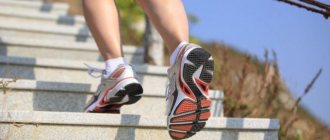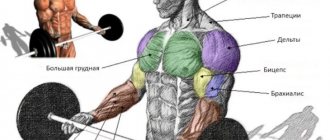walking is a wonderful sport. Yes, yes, walking is a sport. The benefits from it are special. After all, it trains all the same muscles as running. At the same time, it does not have a negative effect on the knee joints. Plus it improves heart function and saturates our cells with oxygen. Everyone can walk: fat and thin, old and young.
Many people care about the topic of weight loss. It is very difficult to fight the hated kilograms while sitting. Forcing yourself to play sports is even more difficult. But going for a walk in the evening after work is as easy as shelling pears!
What are the benefits of walking?
Many are accustomed to thinking that if you get cardio exercise, it must be through running, cycling or skiing. However, walking, just like the exercises listed, strengthens the cardiovascular system, being the most non-traumatic type of activity.
Here are just some of the most noticeable benefits that walking gives your body:
- helps you lose weight or maintain a healthy weight;
- long and fast walks increase endurance;
- helps prevent or manage chronic diseases;
- for people leading a sedentary lifestyle, 20 minutes of walking a day reduces the risk of premature death by 16-30% (American Journal of Clinical Nutrition study);
- for older people, an hour's walk 3 times a week reduces the risk of dementia;
- walking strengthens the heart;
- relieves stress, reduces anxiety;
- Walking as a means of cross-training allows your joints and muscles that are actively involved in running to rest;
- On a rest day from training, walking is an effective way to burn fat and increase blood flow for muscle recovery.
Nutrition for cardio training for weight loss
Cardio training is represented in many sports: cycling, swimming, jumping rope, brisk walking, aerobics, dancing, etc. Diet is an integral procedure that determines the effectiveness of exercise. If the exercises do not involve burning excess fat and body weight is within normal limits, then the diet does not involve serious restrictions. In this case, a normal healthy diet with a slight restriction of animal fats and light carbohydrates is sufficient.
Note! Cardio exercise awakens your appetite, and if you do not follow the diet, you can gain excess weight.
The diet during cardio training should include:
- animal proteins (beef, chicken breast, milk, fish) in a ratio of 60–70% of the daily diet;
- carbohydrates (cereals, cereals, vegetables, fruits) 20% of the daily value;
- vegetable fat (nuts, vegetable oil) at least 30 grams per day.
Important information! Reducing the number of calories (by more than 20%) during cardio exercise can lead to muscle tissue degeneration.
Cardio training on a jump rope
Nutrition after cardio training to burn fat
To achieve the desired result, you must follow proper nutrition before and after training. The main principle of nutrition is:
- carbohydrates - before training;
- proteins - after training.
You cannot exercise on an empty stomach, but you should eat food 1.5–2 hours before training.
Nutrition after exercise is important. Eating is allowed after half an hour.
Option 1:
- complex carbohydrates - 60%;
- protein - 40%.
Option 2:
- fast protein (whey protein, egg white);
- an hour later - protein, complex carbohydrates, fats (40x40x20).
Sources of calories
HOW MANY CALORIES BURN WHEN WALKING
Of course, to lose weight it’s not enough to go shopping. How many calories are burned per hour of walking depends on:
- presence/absence of additional equipment (walking poles, weights);
- your weight;
- your age;
- level of physical fitness;
- pace;
- duration;
- roads (it’s harder to walk uphill);
- intensity of hand movement.
It is clear that if you walk quickly, you will burn more calories than if you walk at a slow pace. Plus, it is better to conduct classes in a park or forest. The load will immediately increase due to unevenness on the road.
In 1 hour of walking you can burn 200 kilocalories or more. You can independently calculate how many calories your body will burn.
For one kilogram of weight, each person spends an hour walking:
- at an average pace (4 km/h) 3.2 kcal;
- at a fast pace (6 km/h) 4.5 kcal;
- almost running (8 km/h) 10 kcal;
There is also a convenient sign where you can see how much you will spend depending on your body weight and walking speed.
| Speed/Body Weight | 50 kg | 55 kg | 60 kg | 65 kg | 70 kg | 75 kg | 80 kg | 85 kg | 90 kg |
| 3 km/h | 126 | 138 | 150 | 163 | 175 | 187 | 201 | 213 | 226 |
| 4 km/h | 160 | 177 | 192 | 209 | 224 | 240 | 257 | 272 | 288 |
| 5 km/h | 184 | 202 | 221 | 239 | 258 | 276 | 295 | 312 | 331 |
| 6 km/h | 217 | 238 | 262 | 283 | 304 | 326 | 349 | 369 | 392 |
| 7 km/h | 291 | 321 | 351 | 379 | 409 | 439 | 467 | 496 | 526 |
| 8 km/h | 374 | 410 | 449 | 487 | 523 | 562 | 598 | 636 | 673 |
| 9 km/h | 480 | 530 | 577 | 625 | 674 | 722 | 769 | 818 | 866 |
That is, if you weigh 55 kg and walk at an average speed, you will lose 202 kcal in an hour.
Considering all this is completely inconvenient. After all, you still need to correctly estimate the speed. If you know exactly the distance traveled, calculating the speed is easy. And if not? Count steps per minute? This will make you more tired than walking itself!
I recommend using a fitness bracelet. You put it on your hand, and he counts how much time has passed. For me, this is a convenient and simple electronic pedometer.
Although there are, of course, many applications on a smartphone - download it for free, install it and use it. They write that it counts the distance traveled, speed and number of calories lost. But is it really that convenient? No matter how many programs I tried, they produced a huge error. I walk 10 steps, and he counts 7 or doesn’t even understand that I’m walking. So you have a choice - toil with a free program, or purchase a specialized device.
How many calories are burned by walking in 1 hour?
If you want to burn more calories and lose weight faster, it is, of course, better to opt for running.
However, walking also provides many health benefits and helps you maintain a healthy weight. Running will require twice as many calories as walking. However, if after running you eat a portion twice as large as usual, you should not expect weight loss.
A man weighing 72 kg will burn 300 calories in an hour of walking at a speed of 5.5 km/h. When running at a speed of 8 km/h, the same man will burn 600 calories. To achieve results in losing excess weight, we recommend combining these two types of exercise.
For example, the author of this article does not use transport if the desired destination is 3 km away or if there is a trip with transfers: you can walk to the stop from where you can leave directly. In addition, sometimes during evening traffic jams it is much faster and more pleasant to walk home or an intermediate stop than to hang on the handrail in a crowded bus.
For owners of personal vehicles, the recommendation is this: do not use your car for short distances. There are several advantages here: health benefits, no need to look for parking, saving on gasoline, reducing the load on road infrastructure. Walking is environmentally friendly!
Don't forget that it's not just your walking speed that affects the amount of energy you consume. Walking uphill will require much more calories than walking on the plain. You can find a hilly area outside or set the incline on your treadmill to 5%. Gradually increase the incline to maximum, usually 15%.
Despite all the obvious benefits of walking, you still have to watch your diet if you want to lose weight. At the National Laboratory. Lawrence Berkeley (USA) collected data from more than 15,000 walkers and 30,000 runners to determine which group lost weight more effectively.
The study found that runners were generally able to control their weight more effectively and were overall slimmer. One likely reason for this is the aftereffect of intense exercise, which increases metabolic rate and increases calorie consumption for 14 hours after activity. There is no such afterburning of calories in walking.
Another reason runners lose weight better is because of their post-workout caloric intake. In a study published in the Journal of Obesity, researchers found that walkers were more likely to overeat than runners after a 60-minute workout.
After the training, all study participants were invited to a buffet where they could choose their dishes. The walkers ate 50 more calories than they burned during exercise, while the runners ate 200 fewer calories than they burned during exercise. Runners were also found to have higher levels of peptide YY, a blood hormone that suppresses appetite. This was not observed among pedestrians.
How fast and how long should you walk to lose weight?
Note that a leisurely walk in the park will not give you enough exercise to increase calorie burning. You need to walk quickly, although, of course, not as quickly as sports walkers rush.
Active burning of calories begins not from the fact that you make any movements, but from an increase in heart rate. For most people, brisk walking starts at 5 km/h (12 min/km). When walking 7 km/h (08:34 min/km) you will burn the same number of calories as when running at the same pace, but even a beginner can run at this pace, but not even an experienced runner can walk.
Trainers recommend varying your walking pace, just as we do during running workouts. Walk at a fast, uncomfortable pace for two minutes, then slow down to a comfortable pace. Repeat as many times as you like. In addition to actively burning calories, it will improve your aerobic fitness. Your heart rate should rise to at least 100 beats at an accelerated pace.
If you run in addition to walking, an hour of brisk walking is enough to increase your daily calorie expenditure. Thus, in Kenneth Cooper’s work “The New Aerobics: A System of Health-improving Physical Exercises for All Ages,” it is said that to achieve satisfactory fitness, you need to walk 6.5 km at an accelerated pace. In general, this is enough for an hour's walk.
So, let’s summarize the effect of walking on weight loss:
- Running burns more calories than walking, but maintaining a high intensity for a long time is more difficult.
- Due to the lower intensity of walking, a higher percentage of calories burned comes from fat burning, but there is no afterburn effect.
- Both walking and running burn enough calories to help you lose weight, but only if you make the necessary changes to your diet at the same time.
The influence of the stepper on the human body
A stepper is a very popular exercise machine that is used to pump up certain muscles of the body. This device is a good cardio machine that simulates climbing stairs. It is mainly used for the purpose of losing weight, but its benefits are not limited to this:
- the heart and blood vessels are strengthened;
- the respiratory system develops;
- strengthens the muscles of the back, abs, buttocks;
- excess weight is lost;
- figure correction;
- improved coordination;
- stimulation of the metabolic process;
- increasing immunity.
Stepper
There are three types of stepper:
- classic - imitates climbing stairs as accurately as possible;
- balancing - additionally develops coordination of movements and strengthens the abdominal muscles; when moving, the center of gravity of the body shifts in different directions;
- rotating - additionally loads the back, since when walking the body turns. This type with the maximum amount of load and works all the muscles of the body in 10 minutes.
Calorie consumption on a stepper
The number of calories burned depends on the intensity of the exercise. Approximate consumption is 500–600 kcal per hour. With a combination of exercise and proper nutrition, excess weight comes off quickly.
What muscles work when walking?
At a slow walking pace of less than 5 km/h, muscle activity is minimal. Power walking starts at 6 km/h. At this pace, the legs, hips, and knees are actively strengthened. The abdominal and arm muscles are used to a lesser extent; the core muscles act as a stabilizer.
When walking uphill, a good load is placed on the quadriceps, gluteus maximus and calf muscles.
Nordic walking, in addition to those already mentioned, uses the muscles of the cervical-brachial region, pectoral and scapular muscles, triceps and biceps.
Correct walking technique
When you don't just walk, but use walking instead of fitness training, you need to take the right steps:
- keep your head up and look forward;
- the neck and shoulders should be relaxed;
- while walking, you need to swing your arms, slightly bending them at the elbows;
- keep your back straight;
- tighten your abdominal muscles and tighten your buttocks;
- step smoothly, rolling your foot from heel to toe.
This way you won’t get tired while walking even over long distances, you can easily take the right pace and tighten the muscles of your hips, abdomen, legs and arms while moving.
How long is it recommended to walk each day?
Everyone has probably heard about 10 thousand steps a day to get rid of all diseases and problems? As in the case of 2 liters of water, this is a stereotype. And it comes from Japan, where the inventor of the first electronic pedometer, Yoshiro Hatano, called it Mampo-kei. Translated into Russian, this means “10,000 steps.” One version of why Yoshiro named his invention this way is that it’s just a beautiful round number.
10,000 steps is approximately 8 km. And many, of course, are frightened by this figure. There is no need to take it literally, because there are a lot of variables: what surface a person moves on, at what speed, in what weather conditions and, finally, what kind of training a person has. Even going up from the 1st floor to the 18th-20th floor a couple of times carries a load that is much greater than idle wandering throughout the day.
A simple rule: less is better, but more is more active. Research from the Active 10 Project shows that 3 brisk, 10-minute walks a day are healthier than 10,000 slow steps. In addition, short but fast walks are better suited for the modern rhythm of life.
The recommended rate of physical activity for a person is at least 150 minutes per week. Such recommendations are given by the World Health Organization. Walking or other activity should be done at least 30 minutes a day, 5 times a week. And this is just to maintain health. Note that physical activity can be distributed throughout the day:
- 10 minutes of brisk walking three times a day;
- or 20 minutes in the morning and 10 minutes later during the day.
Doctors advise counting not the steps taken, but the total time of physical activity, but if you are still interested in the numbers of steps taken, there are now many fitness bracelets on the market with a step counting function. The same mobile applications can be installed on any smartphone.
HOW TO WALK CORRECTLY
You don’t need to immediately start walking quickly for 3 hours a day. Especially if you are no longer 20 years old and do not weigh 50 kg. Start with hour-long walks at a slow pace. Then increase the pace for 5 minutes, then for 10 minutes and so on. Gradually you will begin to walk for 1 hour at an average pace. Want to spend more energy? Then increase the pace again and add time.
The main rule is to walk for at least an hour. When walking, fat begins to be burned no earlier than forty minutes later. Our body is extremely thrifty and first spends available carbohydrates.
Also remember not to exercise immediately after eating. The optimal time for training is an hour after eating. And when you finish your classes, don't rush to eat. Drink a glass of water. You can indulge in an apple or a banana smoothie.
While walking, remember to breathe. Inhale through the nose, exhale through the mouth. It is also important to quit smoking. It negatively affects breathing and the cardiovascular system. Shortness of breath and even dizziness will appear.
Give yourself a nice gift. Buy nice sportswear and comfortable sneakers. Better yet, buy special clothes that help burn fat. For example, breeches for weight loss. They create a sauna effect and help you lose weight much faster.
Advice from trainers and nutritionists during exercise
Trainers and nutritionists recommend adhering to the following rules:
- You cannot limit your fluid intake so as not to provoke a change in water balance. Pure, unadulterated water is best.
- To maintain the required weight, you should be physically active (at least the amount of walking that prevails in everyday life).
- Cardio exercises should be accompanied by a set of strength exercises. Such conditions promote flexibility and the development of good coordination of movements. In order to lose weight, it is necessary to perform complex training.
- The daily diet should include all food groups: proteins, vegetable fats, carbohydrates, fruits and vegetables. It is important to focus more on fruits and vegetables.
- Do not take fat burners that contain guarana and caffeine. Given the current level of stress, such drinks can lead to nervous disorders and cardiovascular diseases.
- The shortest way to a slim figure is joint aerobic and strength exercises and a healthy diet.
If you want to exercise for the purpose of losing weight or strengthening muscles, 2 workouts per week is not enough. Only proper distribution of loads and a balanced diet will help achieve the desired result.
HOW TO INCREASE CALORIES EXPENDED
There are several ways to increase the load. Race walking will make you sweat. But this is a super-effective way to get rid of extra centimeters. The tummy will be flat, and the buttocks will be a sight to behold.
SWING YOUR HANDS
To work your upper body, swing your arms. This will increase the load and walking speed.
Bend your elbows at an angle of 90° and make amplitude swings of your arms back and forth.
ADD WEIGHT
Is it easy for you to walk and don’t you get tired? Try adding weight. This will increase the intensity and challenge your muscles. Avoid wearing weights on your wrists and feet. They can change your gait and posture and increase your risk of injury.
Instead, grab a backpack or weighted vest. If you decide to wear a backpack, fill it with water, sand, or simple cat litter. This will distribute the weight evenly.
If the weather does not allow you to go outside, take the stairs or stay indoors. Do a short warm-up first. How many calories are spent during these types of training, read the article “training options for losing weight.”
WALKING WITH STICKS
It is one of the best ways to increase the number of calories burned. It is suitable for all ages and skill levels. The result is incredible. Nordic walking uses 90% of the muscles in our body and increases calorie consumption by up to 46% compared to normal walking. Poles help reduce stress on the ankle, knee and hip joints.
I recently purchased some poles myself. I noticed that the load on my legs doubled and the muscles of my arms and upper back became involved.
Girls, everything works, the main thing is not to be lazy. After training you feel like you have run several kilometers. Even my back with my osteochondrosis began to hurt less. I really recommend this walk to everyone. For more information on how many calories are spent and how to train correctly, read a separate article about Nordic walking with poles for weight loss.
WALKING ON A TEACHING TRAIL
If it is not possible to walk outside, then walking on a treadmill is the most optimal. On average, a person walks at a speed of 4-5 km per hour. To lose weight and get in good physical shape, you need to increase your pace and walk from 5.5 to 6.5 km per hour. By increasing the pace, you burn about a third more calories. It’s just not worth increasing it any further, because... It will no longer be walking but running. And this is another story, about which I wrote in the article how many calories are lost when running?
UNEVEN RELIEF
Walk on uneven surfaces such as grass, paths, gravel, sand or snow. For example, walking in the snow increases calorie consumption by 2-3 times.
And wearing fins is an even more effective workout?
You can also walk up the stairs or just uphill. You can walk backwards. Or change the pace.
Benefits of walking on stairs?
Not everyone has been able to appreciate the benefits of stair training, but physical activity brings many benefits to the body. This manifests itself in the following moments:
- different groups of leg muscles are strengthened;
- blood vessels are strengthened;
- the endurance of the respiratory system increases;
- the body efficiently consumes and distributes oxygen;
- daily calorie consumption increases;
- general body endurance is developed.
Experienced fitness trainers have noticed that two months of exercise can reduce the waist by 5% and increase lung capacity by 7%. Exercise also helps lower cholesterol levels.
Walking on straight stairs will not be affected by the weather outside, which is a big plus. Inside a private house or on the landing of an apartment building, you can train at any convenient time. And bad weather will not be an excuse for missing a workout.
It is worth noting that coaches of football, volleyball and basketball teams use stairs to develop endurance in players.
How and how much you need to walk per day
Ten thousand steps is a figure that has been recognized as a standard daily requirement, taking into account research and the positive effect on the health of the body. Doctors recommend taking at least eight thousand steps daily. Such movements are the best means of preventing diseases. Positively influence an active lifestyle.
Many people do not set a goal to walk a given number of steps; it depends on the person’s lifestyle and work activity. To feel energized and stay fit, try simply walking. With the help of walking, you can lose extra pounds, improve your health, and increase your mood and positivity.
On average, a person can walk half the norm per day. When working sedentarily, it is difficult to take the required number of steps. By increasing your speed and pace, achieve the same results as when moving normally. It’s easier for couriers in this regard; they can cover three times as much distance.
When working in an office, try to take a ten-minute walk outside during breaks. Improved well-being is guaranteed.
How much to walk to lose extra pounds?
If you want to remove the kilograms that are hindering your figure, make a goal - walk at least 15,000 steps. Fitness bracelets are used to count steps taken; when purchasing a device, you need to learn about entering user parameters in order to receive reliable data.
Some people use a special program in their phones; the device can increase the amount when it vibrates when moving.
By doing daily exercise walks of 10-15 thousand steps and maintaining a diet, it is easy to lose weight without exhausting yourself with heavy loads in the gym. A person weighing 70 kilograms burns approximately 440 calories while doing race walking.
How many steps do children need for healthy development?
A growing body is full of energy, ten thousand for children is the minimum figure. Fidgeting without counting steps heals the body. Overweight children who are less mobile should take 15,000 steps. This will improve your well-being and remove the required amount of calories.
How many steps do retirees need to take?
People of retirement age, like no one else, should take care of their health. Over the years, a person’s performance capacity decreases, which affects well-being.
To delay premature aging, you need to walk or jog a lot. Starting at age 50, the norm is at least 5,000 steps per day.
The number of calories spent walking in 1 hour at different speeds
Beginning athletes are very concerned about how many kcal are spent when walking. This is a controversial question, since how many calories are lost in the body depends on many indicators: the patient’s age, weight, speed of movement, length and duration of movement. The easiest way to calculate energy costs is relative to a kilogram of your own weight for one hour of walking:
- Flat road, speed up to 4 km per hour - 3.2 kilocalories per kilogram of your weight.
- Flat road, speed up to 6 km per hour - 4.5 kilocalories.
- Flat road, speed up to 8 km per hour - 10 kilocalories.
- Climbing up a slope at a speed of up to 2 km per hour - 6.4 kilocalories.
- Long walks in the fresh air (at least two hours) - 6.4 kilocalories.
- Race walking - 6.8 kilocalories.
Those. For an hour-long walk at a speed of up to 6 km/hour, a woman weighing 60 kg will spend about 360 kcal. The list also shows that the greatest amount of energy is spent when walking fast, but such a load is suitable for experienced athletes, and can cause health problems for beginners.
Important! Do not start your introduction to walking with maximum loads. You will “undermine” your body’s defenses, become overtired and become disillusioned with this method of activity.
Choose a load according to your age and strength, this will be much more useful and beneficial.











